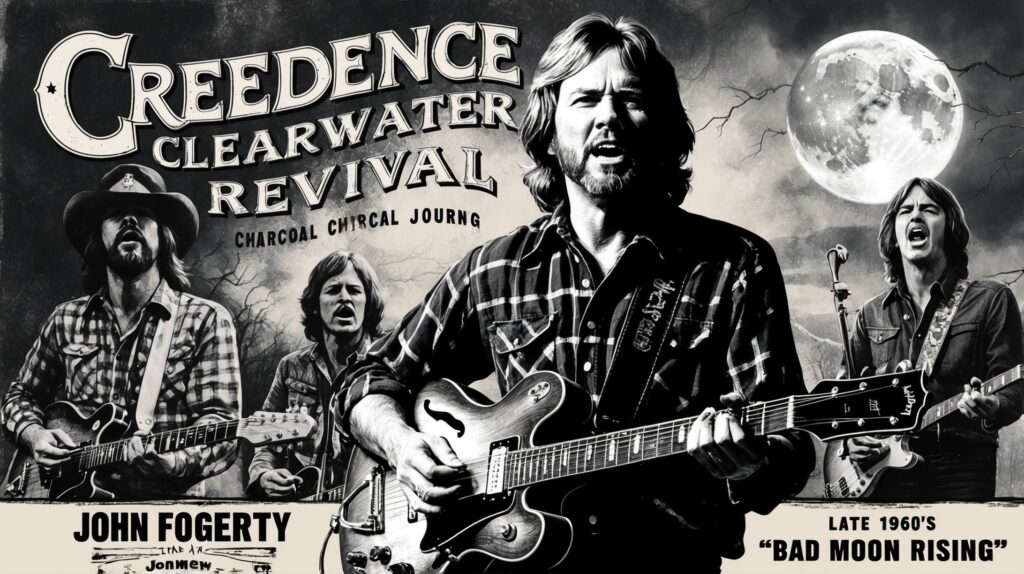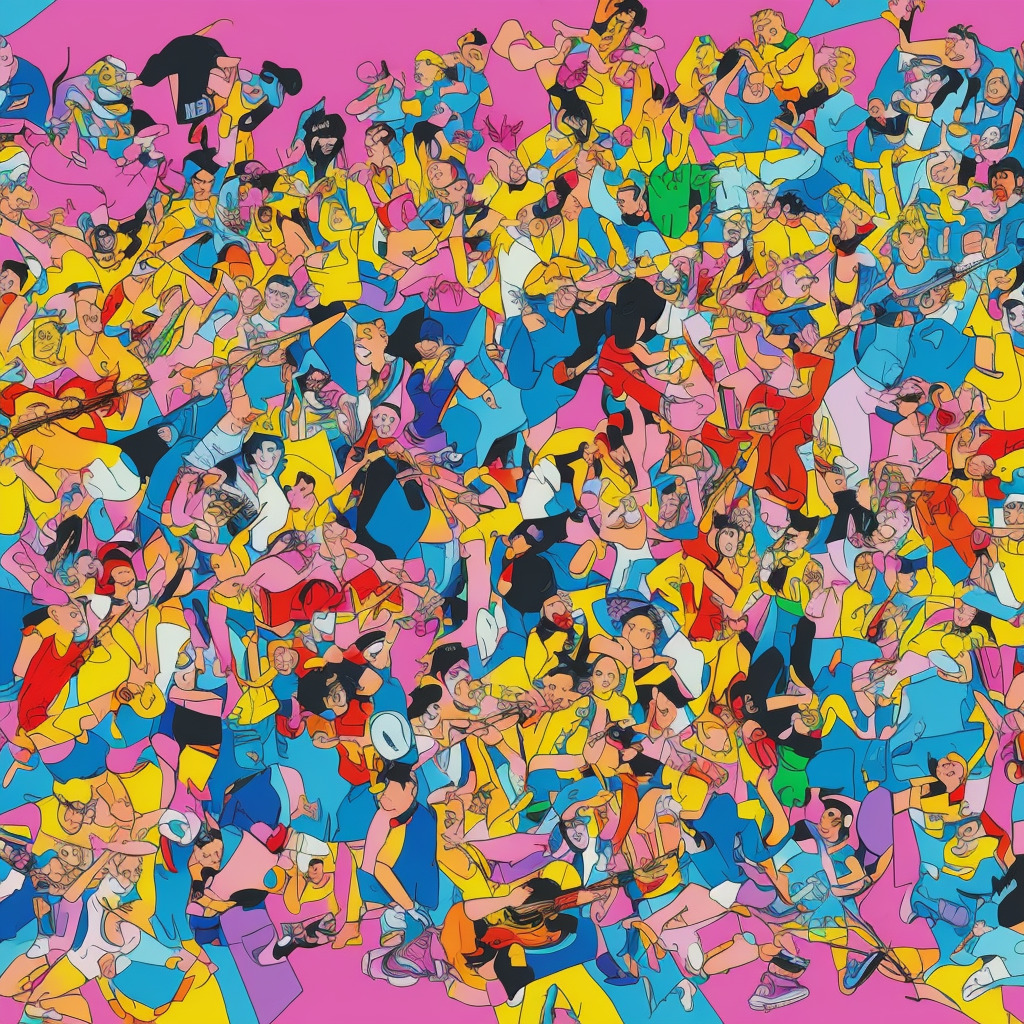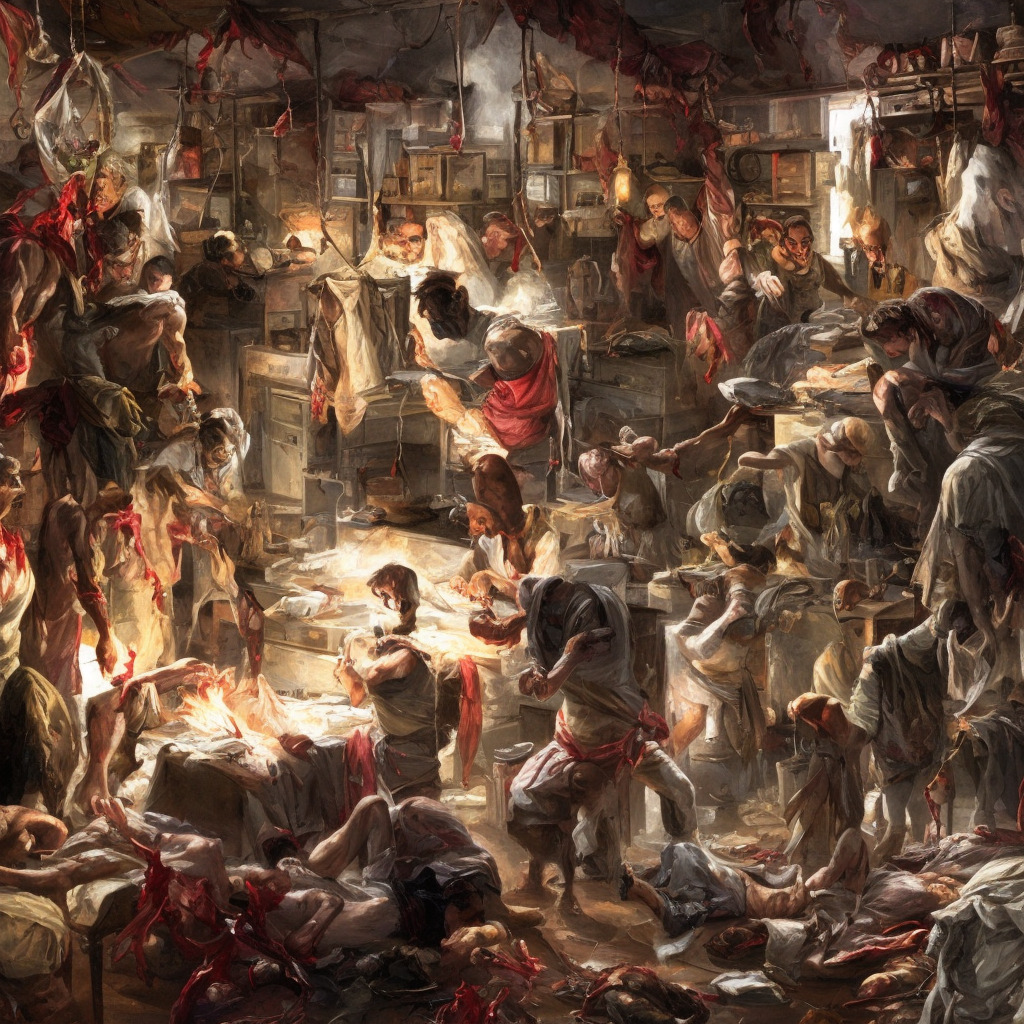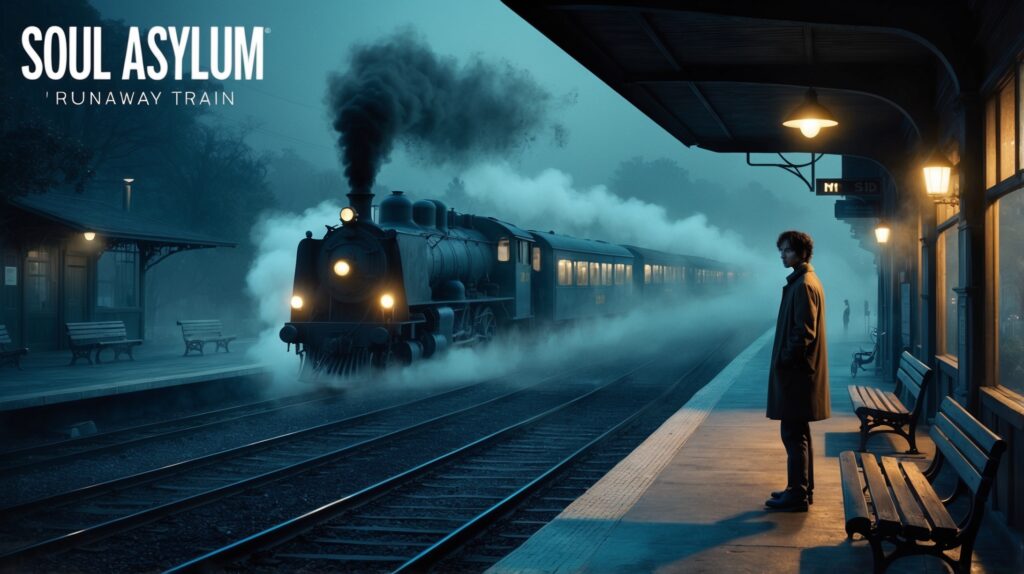Chronicles of Creedence Clearwater Revival
Explore the compelling journey of Creedence Clearwater Revival, the band behind ‘Bad Moon Rising’, and their influence on rock music in a turbulent era.
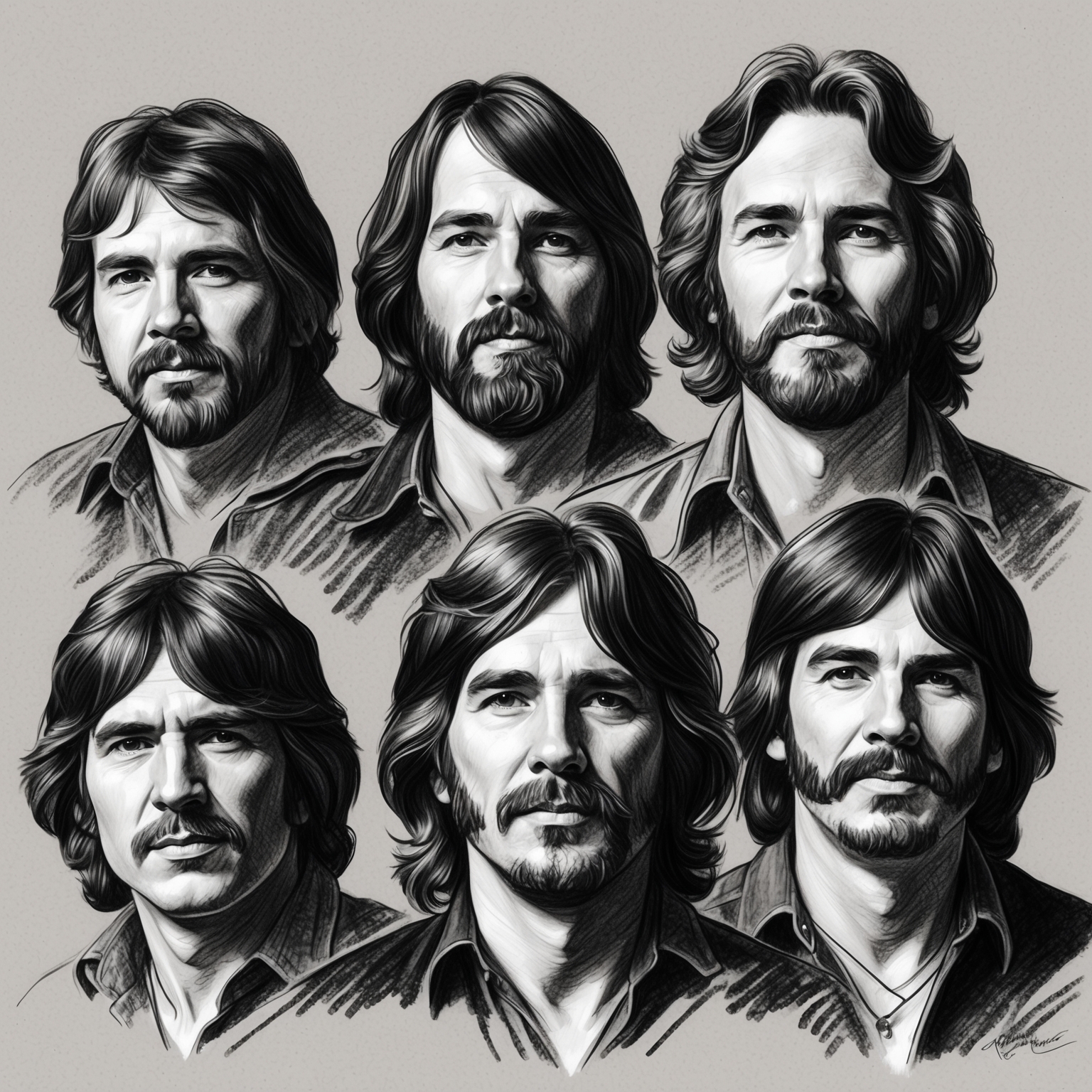
Creedence Clearwater Revival (CCR), an iconic American rock band from the late 1960s and early 70s, played a pivotal role in shaping an entire generation’s musical landscape. With the release of “Bad Moon Rising” in 1969, CCR not only cemented their place in rock history but also captured the zeitgeist of the era with their distinct sound. The song, with its haunting melodies and enigmatic lyrics, became emblematic of the band’s ability to blend rock with elements of blues and country, creating a unique soulful resonance beloved by fans worldwide.
The band formed in El Cerrito, California, initially starting their journey as “The Blue Velvets” in the late 1950s. The transformation into Creedence Clearwater Revival came in the mid-60s when the band members—John Fogerty, Tom Fogerty, Stu Cook, and Doug Clifford—refined their style and adopted a new identity, deeply rooted in Americana and Southern rock. While John Fogerty was often hailed as the driving force with his songwriting and vocal prowess, the synergy among the members was undeniable, leading to a series of hits that defined the era.
The cultural backdrop during the release of “Bad Moon Rising” was that of an America embroiled in turmoil, with tensions of the Vietnam War and societal shifts visible in the fabric of daily life. The music scene was equally dynamic, and CCR’s collaboration with producer Saul Zaentz facilitated the rise of their unique brand of rock and roll. Their tracks were uncomplicated yet carried depth, intertwining catchy rhythms with introspective tones, resonating well with audiences looking for authentic musical narratives.
John Fogerty: The Creative Force Behind ‘Bad Moon Rising’
Discover the genius of John Fogerty, the composer of ‘Bad Moon Rising’. Delve into his musical journey, his distinct style, and his pivotal role in crafting the song’s enduring appeal.
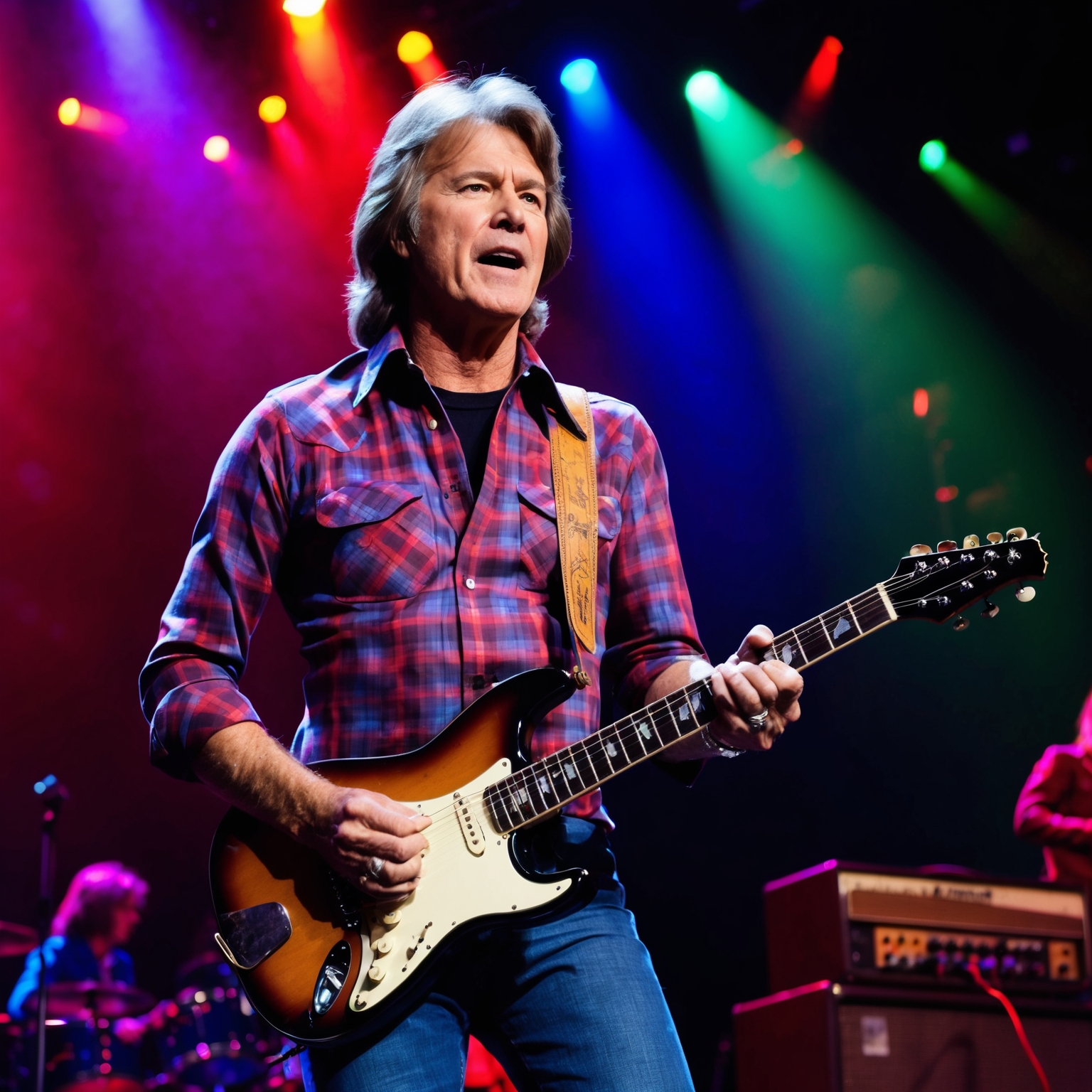
Background and Career: John Fogerty, the mastermind behind ‘Bad Moon Rising’, is renowned as the frontman and lead composer for Creedence Clearwater Revival (CCR). Born in Berkeley, California, in 1945, Fogerty developed an early passion for music, honing his skills as a guitarist and songwriter. His musical journey began with The Golliwogs, a precursor to CCR, where his gritty, sincere vocal style and knack for memorable melodies began to take shape. As CCR grew in popularity, Fogerty’s prowess as a songwriter became increasingly evident, helping to define the band’s unique sound.
Musical Style and Influences: Fogerty’s composition style brilliantly merges rock and roll, swamp rock, and blues, marked by straightforward yet profound lyrics that often reflect social commentary. Influenced by early rock pioneers like Elvis Presley and the raw energy of rhythm and blues, Fogerty’s work is imbued with a rustic authenticity and an evocative narrative style. His influences extend beyond these genres, with hints of folk and country music also permeating his compositions, creating a rich, multi-dimensional sound.
Role in the Song’s Creation: ‘Bad Moon Rising’ showcases Fogerty’s distinctive ability to conjure vivid imagery and atmospheres through his songwriting. Inspired by a sense of foreboding derived from watching a film scene depicting an impending apocalypse, Fogerty penned the lyrics and composed the melody, marrying ominous themes with an upbeat tempo. This juxtaposition has become a signature element of his work, illustrating his innovative approach to songwriting.
Impact on the Song’s Success: Fogerty’s composition played a crucial role in the song’s enduring success. With its catchy tune and prophetic lyrics, ‘Bad Moon Rising’ resonated with audiences, cementing its place as one of CCR’s most iconic songs. The clever interplay between the foreboding lyrics and the buoyant melody created a timeless appeal that has allowed the song to continually garner new fans across generations.
Celebrating the Impact and Influence of ‘Bad Moon Rising’
Explore the far-reaching influence of ‘Bad Moon Rising’ through its numerous covers, media appearances, and its enduring status as a rock classic.
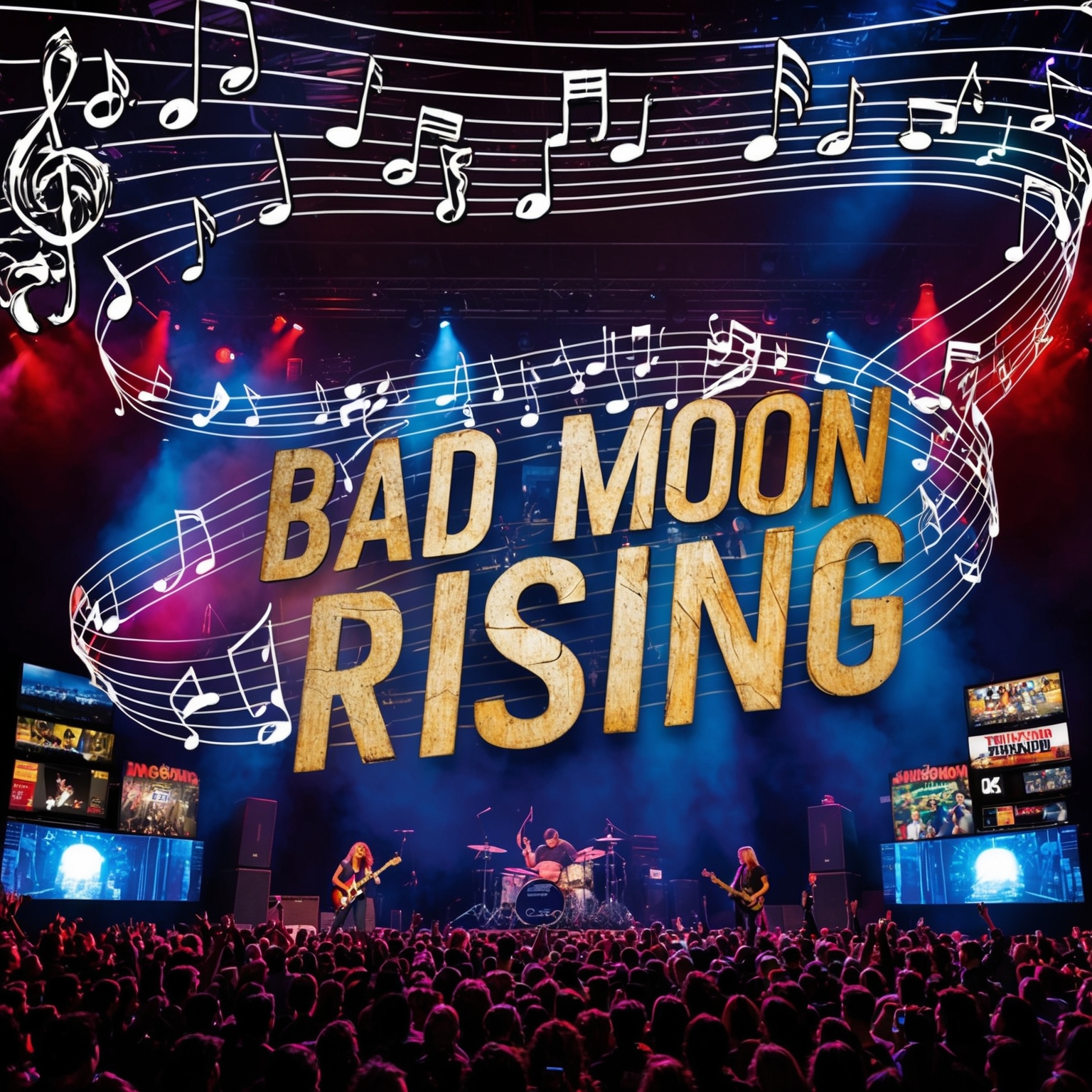
Throughout its enduring legacy, ‘Bad Moon Rising’ by Creedence Clearwater Revival has received numerous accolades and recognition, cementing its status as a rock classic. The song, released in 1969, instantly resonated with audiences worldwide and became a staple in the rock music canon. While it may not have garnered major industry awards due to the times, its success and staying power have given it a perpetual presence in popular culture.
A key testament to the song’s broad appeal is the number of artists who have covered it over the decades. Notable musicians such as Jerry Lee Lewis, Bruce Springsteen, and Emmylou Harris have each put their unique spin on the track, showcasing its versatility and timelessness. Each cover has brought a fresh interpretation, ensuring that ‘Bad Moon Rising’ continues to reach new audiences, further embedding it into the musical tapestry of successive generations.
In addition to covers, ‘Bad Moon Rising’ has also made its mark in various forms of media. The song has featured in several films, TV shows, and video games, reinforcing its cultural footprint. It has appeared in movies like ‘American Werewolf in London’ and TV series such as ‘The Walking Dead,’ creating an atmospheric backdrop that enhances the storytelling. Video games have also embraced the track, with its inclusion in titles like ‘Grand Theft Auto V,’ adding another dimension to its popularity.
The Meteoric Rise and Lasting Impact of ‘Bad Moon Rising’
Bad Moon Rising’ by Creedence Clearwater Revival climbed the charts quickly, reaching number two in the US and topping charts in the UK, solidifying the band’s global appeal and influence.
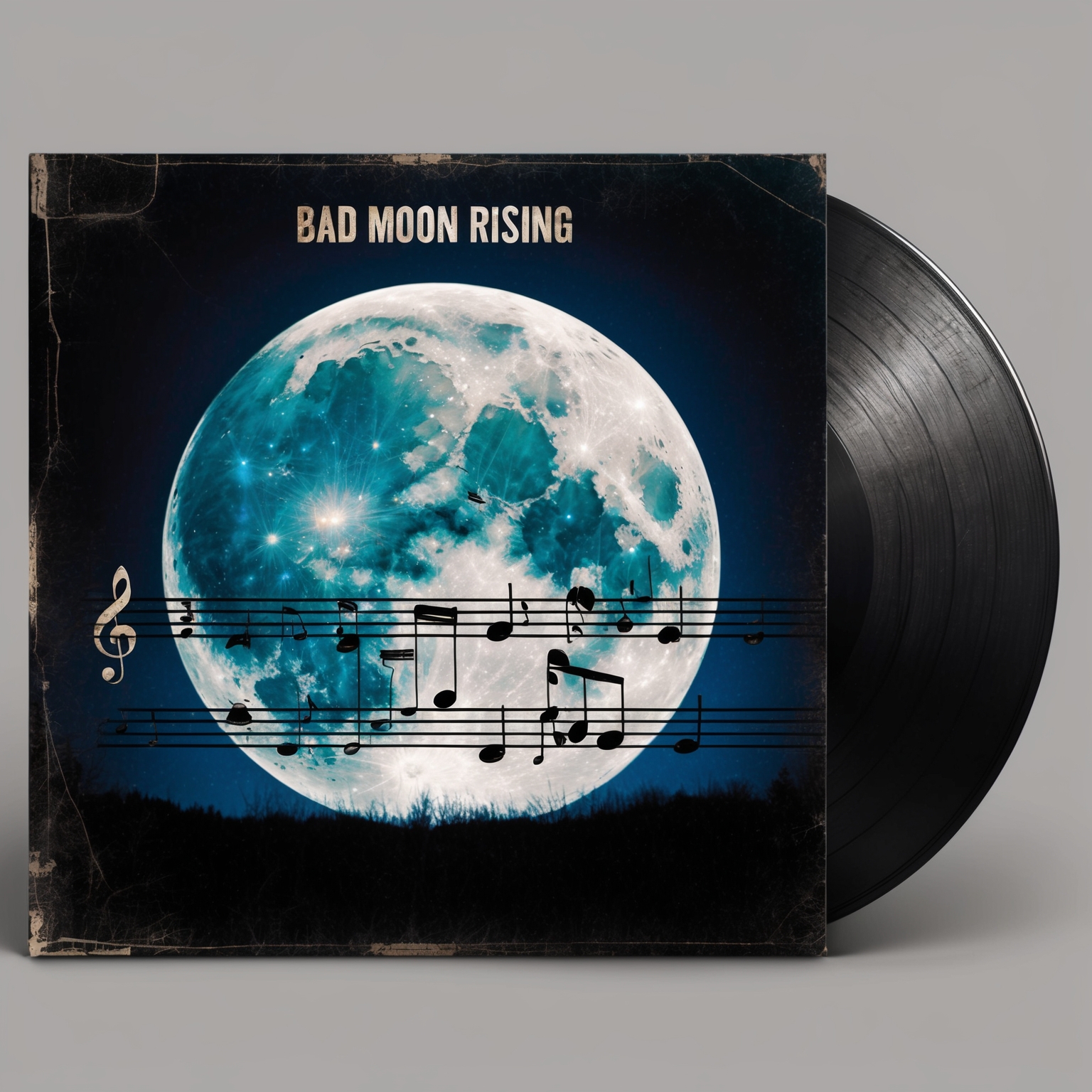
Released in April 1969, ‘Bad Moon Rising’ quickly soared up the charts, becoming one of Creedence Clearwater Revival’s (CCR) most successful singles. The song made its debut on the Billboard Hot 100 in May of the same year, initially entering at position 78. Within weeks, its infectious rhythm and enigmatic lyrics propelled it to the top, peaking at number two. This swift ascent was a testament to CCR’s growing influence in the rock genre and the song’s undeniable appeal. Its chart success wasn’t limited to the United States—in the UK, ‘Bad Moon Rising’ reached the coveted number one spot, illustrating the band’s international draw.
At the time, CCR was not new to success; their distinct sound had already caught the public’s ear with earlier hits. However, ‘Bad Moon Rising’ solidified their stature as a dominant force in the music industry. It followed the breakthrough hit ‘Proud Mary’ and further cemented CCR’s reputation for producing memorable and culturally resonant music. Importantly, this track helped elevate the band’s status, enabling them to build on their momentum and achieve even greater heights in their career with subsequent releases.
Interestingly, the song’s marketing was minimalistic yet effective. Unlike today’s marketing blitzes, the power of ‘Bad Moon Rising’ lay in live performances and radio play. The absence of an elaborate promotional campaign didn’t deter its success; instead, it emphasized CCR’s raw talent and organic connection with their audience. Critically, the song was well-received. Publications praised its catchy melody and thought-provoking lyrics, which cleverly combined ominous themes with an upbeat tempo. Over time, ‘Bad Moon Rising’ transcended its initial era, becoming a timeless anthem familiar to generations of fans. In an age dominated by digital media, the song continues to thrive with robust streaming numbers and playlist inclusions, proving its lasting legacy.
Exploring Visual Interpretations of ‘Bad Moon Rising’
Discover how ‘Bad Moon Rising’ by Creedence Clearwater Revival is visually represented through live performances and fan interpretations, capturing the song’s atmospheric themes.

Creedence Clearwater Revival’s classic track, ‘Bad Moon Rising,’ has left a mark on rock music, making it intriguing to explore how its visual counterparts capture its essence. While the band itself did not produce an official music video given the era in which the song was released (1969), the lack of an official visual representation has invited countless interpretations and reinventions by fans and artists alike.
Perhaps the most captivating aspect lies in live performances and fan-made videos. Many have created their own visual interpretations, often focusing on themes of eerie occurrences and premonitions that the song famously invokes. These videos often intertwine atmospheric elements like ominous stormy skies and footage depicting societal turmoil, fittingly aligning with the song’s portentous lyrics.
Live performances by Creedence Clearwater Revival themselves offered a somewhat unofficial ‘music video’ experience. The band’s energy and musical prowess on stage made live recordings a visualization of the song that spotlighted their raw, authentic style. The collective synergy of band members like John Fogerty and his charismatic delivery brought ‘Bad Moon Rising’ to life in thrilling new dimensions. These visual encounters contributed immensely to the song’s enduring popularity, resonating with audiences even outside traditional music video formats.
Unveiling the Intricacies of ‘Bad Moon Rising’: A Musical Journey
Bad Moon Rising’ showcases Creedence Clearwater Revival’s mastery in creating an engaging musical narrative, with its lively tempo, simple yet effective chord structure, and iconic instrumentation.

‘Bad Moon Rising’ by Creedence Clearwater Revival is a prime example of the band’s ability to craft a tight, energetic composition that resonates with audiences. The song is written in the key of D major, which provides a lively and uplifting backdrop that contrasts with the ominous nature of the lyrics. The chord progression is delightfully straightforward, featuring a repetitive cycle of D, A, and G chords. This simplicity is one of the defining characteristics that make the song so accessible and memorable.
The tempo of ‘Bad Moon Rising’ is brisk and energetic, clocking in at approximately 180 beats per minute. This upbeat tempo propels the song forward, imbuing it with a sense of urgency that aligns perfectly with the cautionary tone of the lyrics. The melody is catchy and invigorating, with the vocal lines weaving seamlessly over the driving rhythm.
The instrumental arrangement in the song further enhances its dynamic appeal. The prominent use of electric guitar, bass, and drums lays down a solid rock foundation. John Fogerty’s gritty guitar work and iconic voice lead the charge, supported by the tight rhythmic interplay of Doug Clifford on drums and Stu Cook on bass. This triad of instruments, along with the occasional addition of piano, contributes to the song’s unique sound. ‘Bad Moon Rising’ is distinctly Creedence Clearwater Revival, a testament to their signature blend of swamp rock and roots influences.
Exploring Themes and Messages in ‘Bad Moon Rising’
This section delves into the introspective and social themes within ‘Bad Moon Rising,’ analyzing the song’s evocative lyrics and their impact during a time of significant cultural change.
I see trouble on the way
I see earthquakes and lightnin’
I see bad times today
Don’t go around tonight
Well, it’s bound to take your life
There’s a bad moon on the rise
I hear hurricanes a-blowin’
…
******* This Lyrics is NOT for Commercial use *******
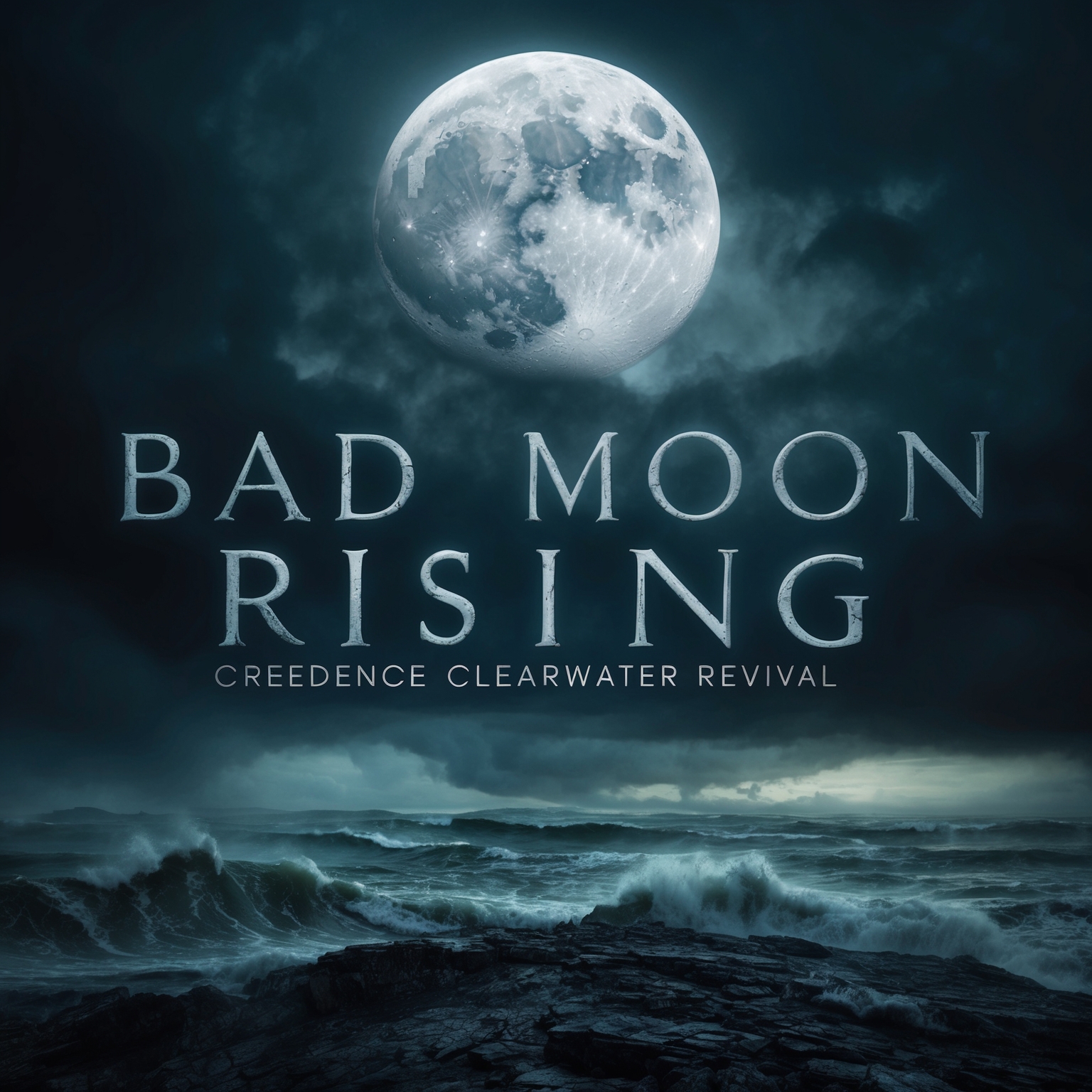
The lyrics of ‘Bad Moon Rising’ by Creedence Clearwater Revival are renowned for encapsulating a sense of foreboding and inevitable change, themes that resonate deeply both personally and socially. Released in 1969, during a time of significant upheaval across the globe with events like the Vietnam War and civil rights movements, the ominous tone of the lyrics can be interpreted as a reflection of the uncertainty and turmoil of the era. The repeated warnings of natural disasters such as ‘earthquakes,’ ‘lightning,’ and ‘hurricanes’ could metaphorically represent the social and political upheavals of the time.
The song’s narrative is delivered in a first-person perspective, lending an urgency and immediacy to its cautionary message. The choice to speak directly to the listener (‘Don’t go around tonight’) intensifies the sense of impending danger, creating an engaging call-and-response effect with the audience. This narrative style not only heightens the emotional impact of the lyrics but also makes them broadly relatable, allowing listeners to project their personal fears and predictions onto the narrative.
Notably, the song employs a straightforward language and a series of vivid, apocalyptic images through its use of literary devices such as metaphor and repetition. The ‘bad moon’ serves as a central metaphor for approaching peril, brilliantly capturing the feeling of dread and anticipation. This use of imagery is comparable to other works of the era, where musicians frequently used nature and celestial motifs to explore deeper societal anxieties. Despite its seemingly dark outlook, the simplicity and repetition in the lyrics ironically contribute to its infectiousness, enabling listeners to easily recall and internalize the song’s message.
🎸🌕 Trivia Time: Bad Moon Rising by CCR was inspired by an apocalyptic scene in a 1941 film, The Devil and Daniel Webster! Rock on with spooky vibes! 🎶 https://bit.ly/4899z7m
Click to Tweet

